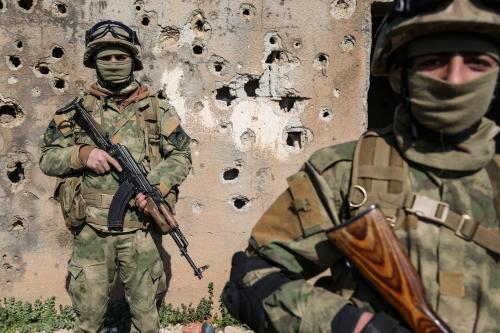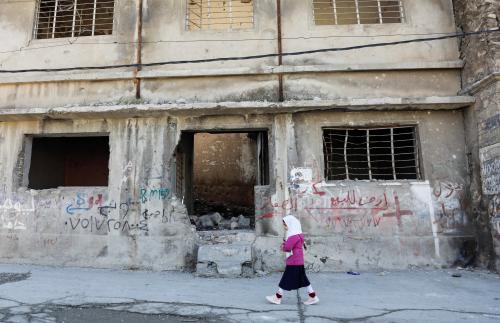On Tuesday, after two months of grueling urban combat against Islamic State militants, the U.S.-backed Syrian Democratic Forces (SDF) declared that “military operations in Raqqa have ceased.” Jubilant soldiers quickly paraded through the bombed-out husk of “Hell Square,” where the Islamic State once carried out its infamous litany of public horrors.
As the self-styled capital of the Islamic State’s caliphate, the significance of Raqqa was always more symbolic than strategic. In contrast to al-Qaida, which has long viewed statehood as a distraction, the Islamic State’s ability and willingness to govern was a central part of its appeal—and Raqqa, as the seat of the group’s power, was a key symbol of its broader state-building enterprise. By retaking the city, the SDF has thus called into question the Islamic State’s animating vision and message. As my Brookings colleague William McCants told the New Yorker: “ISIS put all its chips on creating a state and taking territory as proof of its divine mandate. Some of its followers now have to have doubts.”
Whether the anti-ISIS coalition can capitalize on those doubts remains to be seen. The fall of Raqqa is welcome news, but it also raises important questions about how both Syria and the Islamic State will evolve going forward.
Inside Syria, the central political question now is what happens among the Sunni Arab population the Islamic State once governed. The SDF may have successfully liberated Raqqa, but its primarily secular Kurdish fighters cannot be expected to keep the peace there indefinitely. The United States and its coalition partners will have to identify Sunni actors who enjoy broad local legitimacy, but were complicit in neither the violence of the Islamic State nor the atrocities of the Assad regime. Yet this is a daunting task: Any such actors that existed in 2011 have spent the intervening years targeted by both Assad’s sectarian militias and the Islamic State’s own internal security forces. In lieu of effective Sunni governance, however, the local population will likely give rise to new armed militant groups.
We’ll likely witness either a resurgent al-Qaida or a virulent Islamic State insurgency—or, in the worst-case scenario, both.
Another pressing question concerns the future of the Islamic State’s surviving ideologues. At its height, the group recruited a wide range of true believers, both from within Syria and, most famously, from abroad. Although many of those recruits died on the front lines, thousands more survived. Al-Qaida has already begun actively courting those fighters; Osama bin Laden’s successor, Ayman al-Zawahiri, recently sent an envoy to Syria to encourage them to defect. For its part, however, the Islamic State itself has long been preparing for this moment; before he was killed in an airstrike last year, the group’s spokesman, Abu Mohammed al-Adnani, urged the group’s fighters to ready themselves for an insurgency. Whether the true believers defect or stay put, the prospects for the Islamic State’s diehards are troubling: We’ll likely witness either a resurgent al-Qaida or a virulent Islamic State insurgency—or, in the worst-case scenario, both.
Finally, outside of Syria, the main question now is how effective the Islamic State will be at expanding its foreign networks. If the group’s core appeal lies in its vision for territorial control in the here and now, not some distant apocalyptic future, then it will need to build on its bases abroad. As the figure below shows, one lesson the Islamic State learned from its predecessor organization, the Islamic State in Iraq, was the need to establish foreign capabilities that would be resilient to the group’s defeat in Iraq and Syria itself:
ISIS split off from al-Qaida in Iraq (AQI) in 2013. As the graph illustrates, whereas AQI barely attacked outside of Iraq and Syria at all, the Islamic State has done so far more extensively. Indeed, between 2013 and 2016, its external operations wing proved remarkably successful: The group carried out more than 180 attacks in nearly 20 countries. With its central command in Raqqa lost, the group will likely seek to aggressively expand its nascent “archipelago” of external provinces.
For a countryside devastated by six years of civil war, the fall of Raqqa offers a rare moment of respite. But neither the SDF nor its coalition backers should relish the moment for long: The Islamic State may have lost its capital, but it has not yet lost the larger fight—either inside Syria or out.



Commentary
Raqqa has fallen. Has ISIS?
October 19, 2017